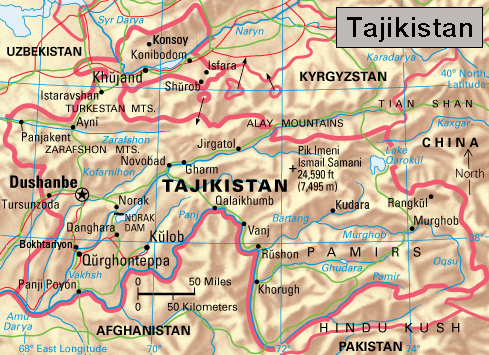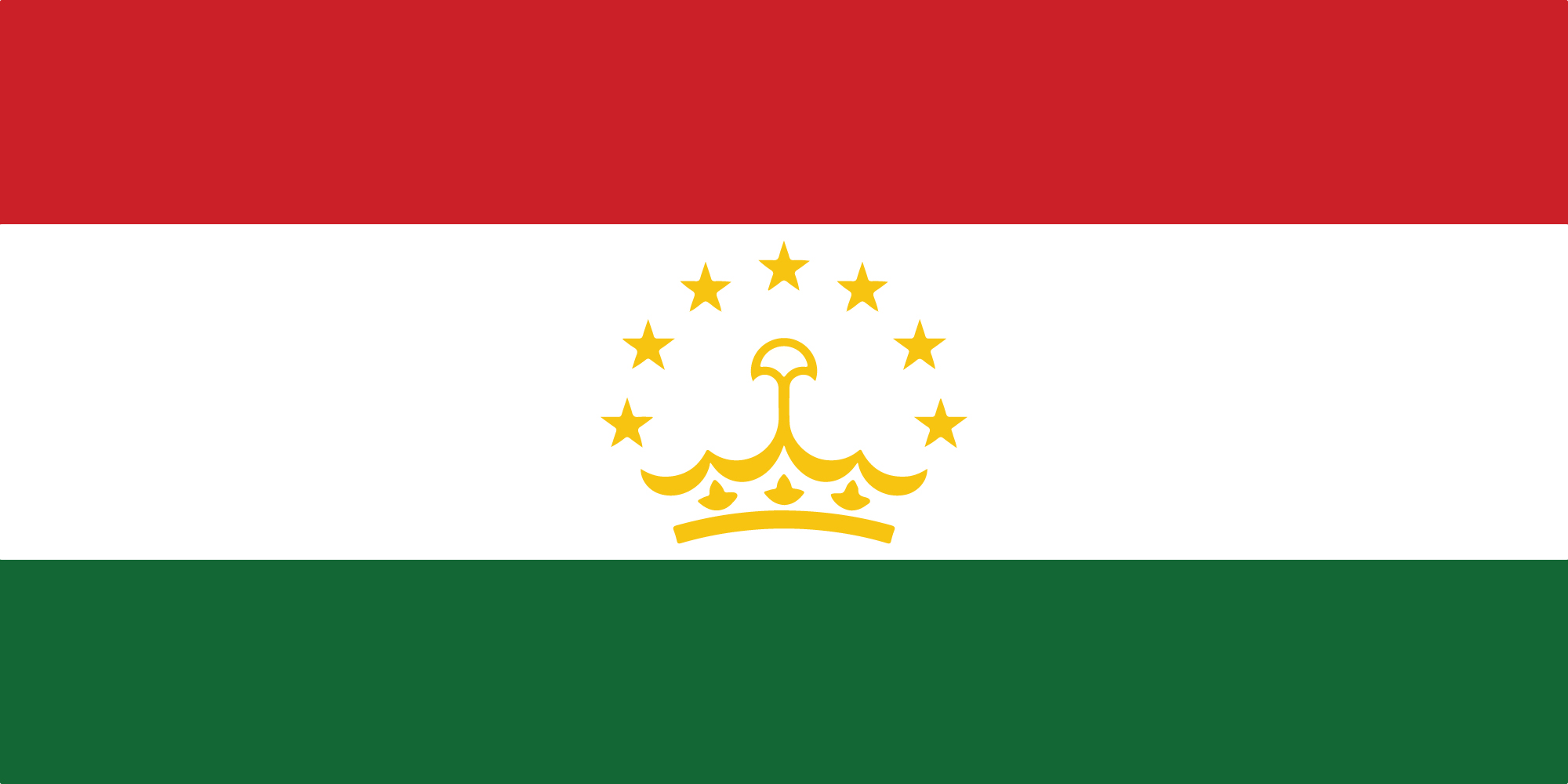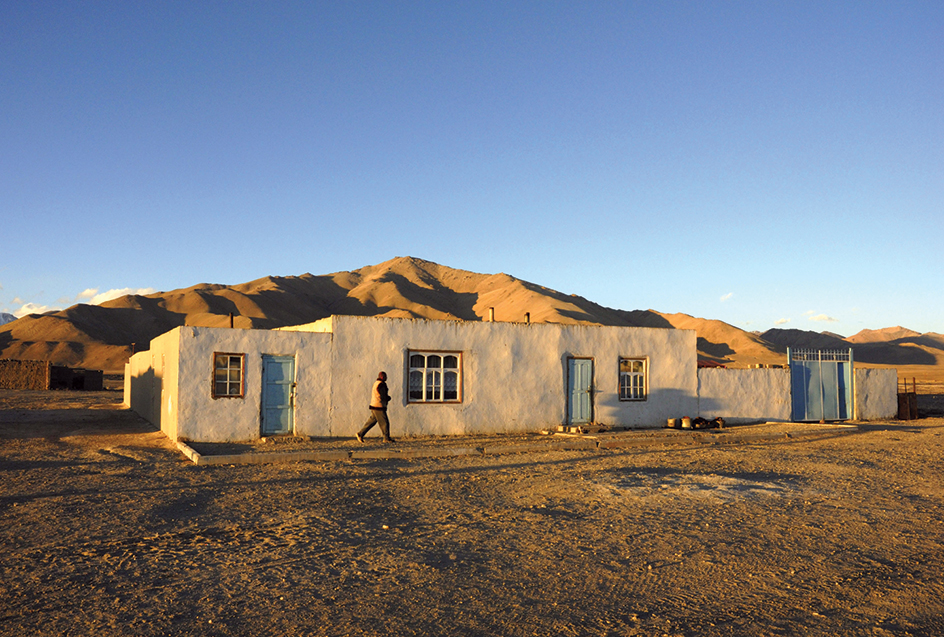Tajikistan << tuh `jihk` uh STAN >>, also spelled Tadzhikistan, is a mountainous country in central Asia. Its name in the Tajik language is Jumhurii Tojikiston (Republic of Tajikistan). Its capital and largest city is Dushanbe. Tajikistan became independent in 1991, after more than 60 years as a republic of the Soviet Union.

Government.
Tajikistan is a republic. The head of state is the president, who is elected by the people.

The president appoints a prime minister, who heads a cabinet called the Council of Ministers. The cabinet helps carry out the functions of the government. The president also appoints council members. A two-house parliament makes Tajikistan’s laws. The main units of local government are regions and cities.
Tajikistan’s highest court is the Supreme Court. There are also regional courts and local courts.
People.
About 80 percent of Tajikistan’s people are ethnic Tajiks. Uzbeks make up about 15 percent of the population. Other ethnic groups include Kyrgyz, Russians, and Turkmen.
Most Tajiks are Sunni Muslims. Groups of Shī`ite Muslims live in remote mountain areas. Small communities of a sect called the Ismaili Khoja Muslims live in the Pamirs, a mountain range in southeastern Tajikistan.
The most heavily settled regions of Tajikistan are valleys in the southwest. Most people live in rural villages that are made up of sun-dried earthen houses surrounded by earthen walls. City dwellers live in single-story houses and multistory apartment buildings.
Most families in Tajikistan are large. Many members of an extended family may live together in one household, including parents, married children and their offspring, and other relatives. Because of marriage patterns, it is common for all people in a village to be related. Some Tajiks follow a Muslim custom that permits a man to have as many as four wives.
Tajiks wear both Western-style and traditional clothing. Traditional garments include loose cotton trousers and a dark or multicolored robe for men and colorful, embroidered silk dresses for women. Both men and women wear embroidered skullcaps.

The country’s official language, Tajik, is an Iranian language. It is much like Farsi, the chief language of Iran.
The government requires children to attend school from the ages of 6 to 17. Tajikistan has several universities and other schools of higher education.
Land and climate.
Over 90 percent of Tajikistan is mountainous, and over half lies above 10,000 feet (3,050 meters). The highest peaks are snow-covered all year. The towering Pamirs rise in the southeast. The Alay and Tian Shan mountain ranges stretch across much of the rest of the country. Fedchenko Glacier, one of the world’s longest glaciers, extends 48 miles (77 kilometers) in the Pamirs. The Amu Darya, a major river of central Asia, flows along part of Tajikistan’s southern border. Another major river, the Syr Darya, flows across part of northeastern Tajikistan. Other rivers include the Vakhsh, Kofarnihon, and Zarafshon. Earthquakes often occur throughout the region.

Summers in the valleys are typically long, hot, and dry. Winters in the highlands are long and cold. Temperatures in the valleys average 36 °F (2 °C) in January and 86 °F (30 °C) in July. Temperatures in the highlands average -4 °F (-20 °C) in January and 72 °F (22 °C) in July. In parts of the eastern Pamirs, temperatures can drop to -49 °F (-45 °C). Tajikistan’s valleys receive from 6 to 10 inches (15 to 25 centimeters) of rain each year. Higher elevations receive much less rain.
Economy.
About half of Tajikistan’s people are employed in agriculture. Leading crops include cotton, various fruits, onions, potatoes, rice, tomatoes, and wheat. Farmers also raise beef and dairy cattle, goats, and Karakul sheep. Chief agricultural areas lie in the country’s southwest and north.
Manufacturing accounts for much of Tajikistan’s economic production. The country manufactures aluminum, chemicals, food products, and textiles. Mined products include antimony, coal, gold, lead, mercury, natural gas, petroleum, salt, and silver. The huge Nurek Dam on the Vakhsh River provides hydroelectric power for industries and water for irrigation projects.
Tajikistan imports more than it exports. The country imports aluminum oxide, food, and petroleum products. The country exports aluminum and aluminum products, cotton, and food products. Tajikistan’s chief trading partners include China, Kazakhstan, Russia, and Turkey.
Driven by high unemployment and underemployment, many Tajiks have sought temporary or permanent work abroad, primarily in Russia. Money sent back to Tajikistan from these migrant workers has become a major economic resource.
Tajikistan has a limited highway and railroad system. Heavy snows close roads in the Pamirs at least half of the year. An international airport is in Dushanbe.
Newspapers are published in several languages. The government controls much of the means of communication in Tajikistan.
History.
People have inhabited the area that is now Tajikistan for thousands of years. Persians of the Achaemenid Empire settled in the region as early as the 500’s B.C. These Persians became the ancestors of the Tajiks. They ruled the region until Alexander the Great of Macedonia gained control of their empire in 331 B.C.
After Alexander’s death in 323 B.C., the region split into a number of independent states. Part of Tajikistan was absorbed by the Seleucids, who ruled until about 250 B.C. Another part came under the control of the Bactrian State, which ruled until about 130 B.C. At that time, nomadic tribes from western China invaded the region. These tribes were overthrown by the Kushans by the A.D. 100’s. Sassanians from Persia and White Huns from central Asia defeated the Kushans by the 400’s.
Arab armies swept into the region in the mid-600’s and introduced Islam. Turkic tribes began moving into the region in about the 700’s. Various Turkic peoples from eastern Persia and central Asia ruled what is now Tajikistan from about 900 to 1200. Mongols led by Genghis Khan conquered the region in the 1200’s. Turkic tribes called Uzbeks ruled from the 1500’s to the 1800’s.
Soviet rule.
In the late 1800’s, czarist Russian forces conquered part of the region. In 1917, revolutionaries known as Bolsheviks (later called Communists) took control of Russia. By 1921, Russians controlled all of what is now Tajikistan. In 1922, the Soviet Union was formed under Russia’s leadership. A rebel group of nationalist Muslim Tajiks known as the Basmachis resisted Soviet control into the mid-1920’s. In 1924, the Tajik Autonomous Soviet Socialist Republic was formed within the Uzbek Soviet Socialist Republic. In 1929, it acquired additional territory inhabited mostly by Uzbeks and became the Tajik Soviet Socialist Republic.
The Soviets made many changes in Tajikistan. The Soviet government built roads, railroads, schools, and modern housing. It also developed industries, especially agriculture and mining. In addition, the Soviets collectivized agriculture—that is, they transferred control of farms and livestock to the government. They also tried to reduce the influence of Islam and prohibited the Tajiks from practicing many of their traditions.
In the 1980’s, opposition groups began to protest against the Communist-controlled government, demanding better housing and more control over their own affairs. In 1989, Tajik replaced Russian as the official language of the republic. In 1990, Tajikistan declared that its laws overruled Soviet laws. In September 1991, Tajikistan declared its independence. In December, it joined other republics in a loose association called the Commonwealth of Independent States. The Soviet Union was formally dissolved on December 25.
Since independence.
In September 1992, anti-Communist and Islamic opposition groups forced the resignation of President Rakhman Nabiyev, a former Soviet Communist Party chief. In November, the opposition groups were forced out of power by supporters of the former government, most of whose leaders were former Communist officials. The parliament eliminated the office of president and made the chairman of parliament the head of state. These events triggered violence and led to a civil war. Tens of thousands of people died in the fighting, and hundreds of thousands fled their homes. The war also disrupted the country’s economy.
In November 1994, a new constitution abolished the office of chairman and reestablished the office of president. Emomali Rahmonov was elected president. In 1997, the government and opposition leaders signed a peace agreement to end the civil war. Rahmonov was reelected in 1999 and 2006. In March 2007, Rahmonov ordered all Tajiks to drop Russian-style last names to signify a break with their Soviet past. Rahmonov changed his name to Emomali Rahmon. He was reelected in 2013. In a 2016 referendum (direct vote of the people), voters overwhelmingly supported a constitutional amendment that allowed Rahmon to run for an unlimited number of terms in office.
